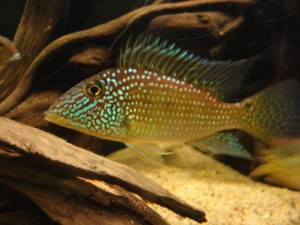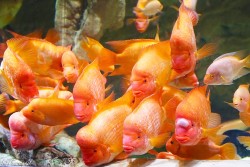Geophagus Jurupari Cichlid (Satanoperca jurupari) Demon Eartheater for Sale: Size, Tank, Care, Types, Breeding
 Geophagus jurupari Cichlid (Satanoperca jurupari) Demon Eartheaters love to dig into the substrate while searching for food. Satanoperca jurupari is an excellent addition to a large sized South American community tank.
Geophagus jurupari Cichlid (Satanoperca jurupari) Demon Eartheaters love to dig into the substrate while searching for food. Satanoperca jurupari is an excellent addition to a large sized South American community tank.The species is a mouth-brooder, meaning it protects the young fry in the mouth. The genus name 'Geophagus' means 'eartheater' which refers to its habit of sifting through the substrate as it searched for food. Its impact on the native ecology is unknown; introduction of non-native species to any water body is not to be encouraged as this can prove disastrous to native fish species which may be out-competed.

Geophagus Jurupari Cichlid Video
A Brief Overview
Geophagus jurupari, commonly known as the Jurupari Cichlid, is a fascinating species of cichlid native to the Amazon Basin in South America. These fish are highly sought after by aquarium enthusiasts due to their stunning appearance and interesting behavior. Let's delve deeper into the world of Geophagus jurupari.
Appearance and Coloration
Geophagus jurupari is renowned for its striking appearance. They typically have a laterally compressed body with a distinct disc shape. Their coloring can vary, but they often exhibit a combination of vibrant oranges, blues, and yellows. A distinguishing feature is a bold black stripe running horizontally across their body, from their eye to their caudal fin.
Natural Habitat and Behavior
In the wild, Geophagus jurupari inhabits slow-moving rivers, flooded forests, and oxbow lakes in the Amazon Basin. They are often found in areas with soft, acidic water and sandy substrate. These cichlids are known for their unique feeding behavior, which involves sifting through sand to uncover small invertebrates and plant matter.
Geophagus jurupari are typically peaceful but can become territorial during the breeding season. They are also known to form small social groups in the wild.
Creating the Perfect Geophagus jurupari Habitat
To create an ideal habitat for Geophagus jurupari in your aquarium, consider the following: 1. Tank Size: Provide a spacious tank with a minimum size of 55 gallons for a pair or small group. 2. Substrate: Use fine sand or smooth gravel as substrate to mimic their natural environment. 3. Water Parameters: Maintain water conditions with a pH level of 6.0-7.5, temperature between 78-84°F (25-29°C), and soft to moderately hard water. 4. Decorations: Include driftwood, rocks, and plants to provide hiding spots and create a natural feel. 5. Filtration: Use a good filtration system as Geophagus jurupari can be messy eaters.
Feeding Geophagus jurupari
Geophagus jurupari are omnivorous and will accept a varied diet. Offer them a mix of high-quality pellets, flakes, frozen foods like brine shrimp, and occasional live foods. Don't forget to include some plant matter in their diet, as they graze on algae and detritus in the wild.
Breeding and Reproduction
Breeding Geophagus jurupari can be rewarding. Here's how to encourage breeding:
1. Pair Formation: Observe your group and allow a pair to form naturally based on their interactions.
2. Spawning Site: Provide flat stones or tiles as potential spawning sites.
3. Courtship Ritual: The male will display vibrant colors and court the female. Once they pair off, the female will lay eggs on the chosen substrate.
4. Parental Care: Both parents will guard and care for the eggs and fry.
5. Fry Care: After hatching, the fry can be fed with baby brine shrimp and finely crushed flakes.
Frequently Asked Questions
1. What size tank is suitable for a Geophagus jurupari pair?
A minimum tank size of 55 gallons is recommended for a pair of Geophagus jurupari.
2. Do Geophagus jurupari need specific water parameters?
Yes, maintain a pH level of 6.0-7.5, a temperature between 78-84°F (25-29°C), and soft to moderately hard water.
3. Are Geophagus jurupari aggressive towards other fish?
They are generally peaceful, but territorial during breeding. Compatibility depends on the tank setup and other tankmates.
4. What should I feed Geophagus jurupari?
Offer a varied diet of high-quality pellets, flakes, frozen foods, and occasional live foods.
5. How do I know when Geophagus jurupari are ready to breed?
Look for courtship behavior, such as color changes and mating rituals. Provide suitable spawning sites to encourage breeding.
6. What is the lifespan of Geophagus jurupari in captivity?
With proper care, they can live up to 10-12 years in captivity.
Conclusion
Geophagus jurupari, with its stunning colors and interesting behaviors, can be a captivating addition to your aquarium. By creating a suitable habitat, offering a balanced diet, and understanding their breeding needs, you can enjoy the beauty and charm of these Amazonian cichlids in your own home aquarium.
References
Synspilum Cichlid (Paratheraps vieja) for SaleNandopsis salvini for Sale
Heros sp. rotkeil for Sale
Hypsophrys nicaraguensis for Sale
Aequidens pulcher for Sale
Geophagus altifrons
Possibly the most magnificent looking Eartheater.
Geophagus altifrons "Tapajos" is an easy-to-keep cichlid.





